Roses are known as the “Queen of Flowers,” because of their beauty and fragrance. Among the different colors of roses, yellow roses usually stand out and thus are common in occasions such as weddings, birthdays and anniversaries.
However, what many people may not know is that there are numerous varieties of yellow roses, each with their unique charm and characteristics. From the classic hybrid tea roses to the trendy floribunda and shrub roses, there are many types of yellow roses available, each with their own yellow color shade, growth habits, shape, bloom times and scents.
The various shades of yellow, from pale lemon to deep gold, make yellow roses something of some worth. So let us look at the different varieties of yellow roses, to help you choose the perfect yellow rose for your garden, bouquet or vase.
List of Yellow Roses
- Julia Child Rose
- Oregold Rose
- Teasing Georgia Rose
- Henry Fonda Rose
- Sunsprite Rose
- Sun flare Rose
- Sunshine Daydream Rose
- Midas Touch Rose
- Lady Bank Rose
- Golden Celebration
- Graham Thomas
- Jude the Obscure
- Rose Charlotte
- Lady Emma Hamilton
- Rosa ‘Crocus Rose’
- Rosa ‘Comte de Champagne’
Facts And Characteristics
Julia Child Rose
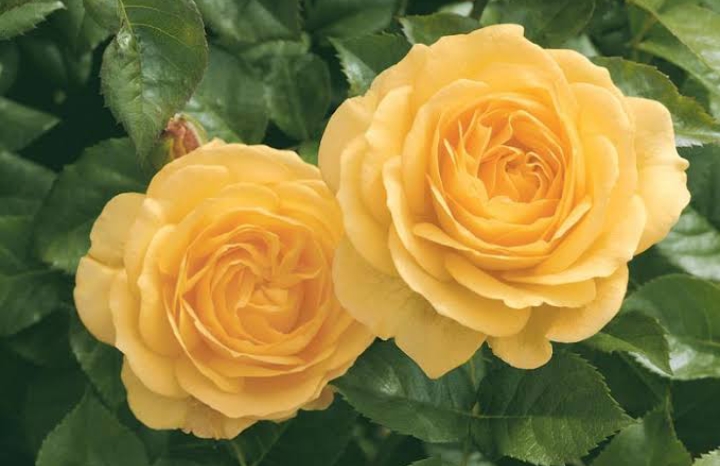
The Julia Child rose, also known as the “Buttergold” rose, is a floribunda rose that was introduced in 2004 by the American rose breeder Tom Carruth. This rose was named after the famous American chef Julia Child, who was a cooking teacher, author and television personality.
The rose has large, buttery yellow blooms, which have a classic, old-fashioned shape and are produced in clusters of about 3 flowers per stem. The blooms have a mild, sweet fragrance with a hint of licorice.
This rose has a medium-sized growth habit, reaching a height of 2 to 4 feet. The Julia Child rose is a repeat bloomer, producing waves of flowers throughout the growing season from late spring to fall. It is a hardy rose, suitable for growing in USDA zones 4-9.
Other Facts and Data
| Scientific Name | Rosa ‘Julia Child’ |
| Type of Rose | Floribunda Rose |
| Origin | United States |
| Year of Introduction | 2006 |
| Breeder | Tom Carruth in 2004 |
| Size | 2 to 4 feet in height |
| Foliage | Bright-green |
| USDA Zones | 4-9 |
| Marketing Names | ‘Soul Mate’, ‘SASOL Rose’ or ‘Anisade’ |
| Awards | All American Rose Selections (AARS) in 2006, Gold Star of the South Pacific in 2011. |
Oregold Rose
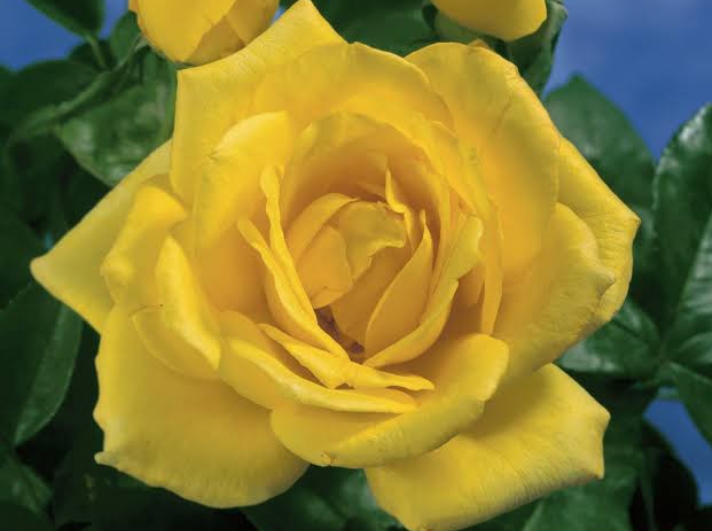
Oregold rose (aka TANolg) is a deep yellow hybrid tea rose bred by Mathias Tantau, Jr in Germany in late 1960s. It is a cross between the yellow hybrid tea rose ‘Golden Holstein’ and the pink hybrid tea rose ‘First Prize’.
Mathias Tantau Jr. was a renowned rose breeder who developed many popular rose varieties in the 20th century. In 1971 the rose was named after the famous German opera singer, Anneliese Rothenberger (1924-2010).
The rose was introduced in the United States in early 1980s by Weeks Roses, who acquired the rights to distribute the rose in North America. Where it began to sell it under the name Oregold rose.
Oregold is a tall upright shrub 5 to 7 feet in height. The plant produces large, double flowers with a high-centered bloom form and a deep, golden-yellow color, fading to buff.
This rose variety is hardy in USDA zones 6a through 10b, which means it can tolerate temperatures ranging from -5 to 30 degrees Fahrenheit (-21 to -1 degrees Celsius). The plant blooms in flushes from spring through fall.
Other Facts and Data
| Scientific Name | Rosa ‘Oregold’ |
| Cultivar Group | Hybrid Tea Rose |
| Origin | Germany |
| Year of Introduction | 1972 |
| Breeder | Mathias Tantau Jr |
| Size | 5 to 7 feet in height |
| Foliage | Dark, glossy green |
| USDA Zones | 6a to 10b |
| Marketing Names | Miss Harp, Anneliese Rothenberger or Tantau |
| Awards | All American Rose Selections (AARS) in 1975 |
Also Read: Different Types of Maple Trees
Teasing Georgia Rose
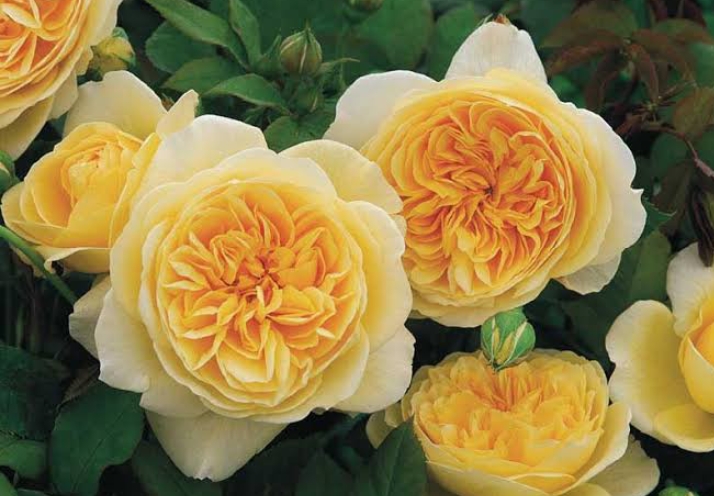
Rosa ‘Teasing Georgia’ is a type of yellow rose cultivar, bred by British rose breeder David C.H. Austin in 1987. It is named in honor of German journalist, Gorgia Tornow. The rose is part of the David Austin English Rose Collection.
The rose was introduced to the market in 1998 and is a moderately sized shrub that can grow up to 5 feet tall. The rose plant produces large, cup-shaped flowers that are filled with numerous petals. The blooms have a rich, buttery yellow color that fades to a softer yellow as they mature.
The flowers in general have a strong tea rose fragrance. This rose cultivar is rated as hardy in USDA zones 5 through 9, which means that it can tolerate temperatures as low as -20 degrees Fahrenheit (-29 degrees Celsius) in the winter.
Rosa ‘Teasing Georgia’ has won several awards in the UK and around the world for its beauty. It was awarded the Royal Horticultural Society’s Award of Garden Merit in 2000, which is given to plants that are deemed to be of outstanding and suitable for garden cultivation. In the same year, it was also awarded the Henry Edland Medal in recognition of its exceptional fragrance.
Other Facts and Data
| Scientific Name | Rosa ‘Teasing Georgia’ |
| Type of Rose | English Rose |
| Origin | United Kingdom (UK) |
| Year of Introduction | 1998 |
| Breeder | David C.H. Austin in 1987 |
| Size | 3 to 5 feet in height |
| Foliage | Bright-green |
| USDA Zones | 5-9 |
| Marketing Names | ‘Teasing Georgia’ |
| Awards | Royal Horticultural Society’s Award of Garden Merit and Henry Edland Medal in 2000 |
Henry Fonda Rose
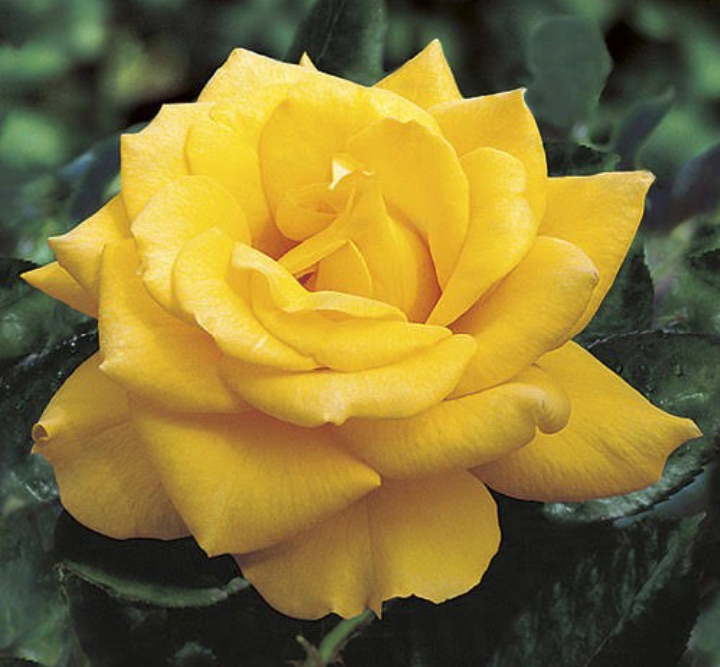
The Henry Fonda Rose is a hybrid tea rose named in honor of the legendary American actor, Henry Fonda. Henry Fonda’ was bread by American hybridizer, Jack E. Christensen from an unnamed seedling and the hybrid tea rose, ‘Sunbright’, in 1995. It was later introduced to the United States market in 1996 by Bear Creek Gardens and Jackson & Perkins Nursery.
‘Henry Fonda’ is a tall upright rose about 4 or 6 feet tall. The rose has large, classic-shaped blooms with a high-centered form. The petals of the flower are a vibrant shade of yellow that fades to pale yellow at the edges. The flower’s edges can sometimes look frayed or torn. The blooms are produced singly or in clusters of two to three and have little or no fragrance.
The Henry Fonda Rose is winter hardy in USDA zones 6 to 9, where it can tolerate temperatures as low as -10 to 0 degrees Fahrenheit. With proper care, this rose can bloom repeatedly throughout the growing season.
Henry Fonda Rose won the All-America Rose Selections (AARS) award in 1997, a prestigious award for roses in the United States. It also awarded the National Garden Bureau’s “Year of the Rose” award in 2000.
Other Facts and Data
| Scientific Name | Rosa ‘Henry Fonda’ |
| Type of Rose | Hybrid tea rose |
| Origin | United States |
| Year of Breeding | 1995 |
| Year of Introduction | 1996 |
| Breeder | Jack E. Christensen |
| Size | 4 to 6 feet in height |
| Foliage | Dark-green |
| USDA Zones | 5-9 |
| Marketing Names | ‘Henry Fonda’ |
| Awards | All-America Rose Selections (AARS) in 1997 and National Garden Bureau’s “Year of the Rose” in 2000. |
Also Read: Different Types of Floribunda Roses
Sunsprite Rose
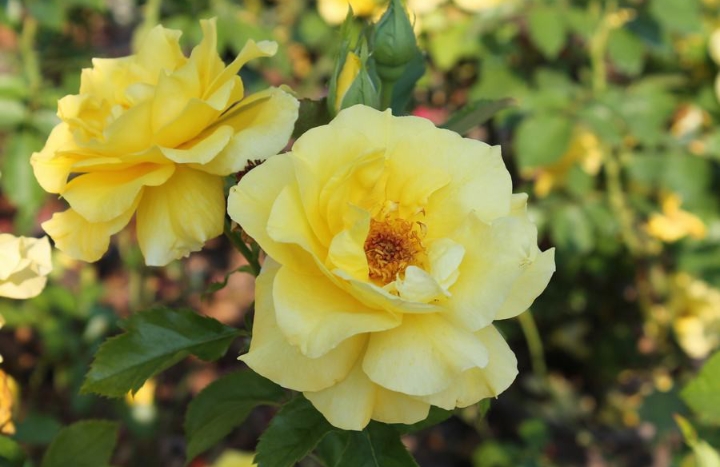
Sunsprite Rose, also known as KORresia or Friesia, is a rose cultivar that was developed by Reimer Kordes and introduced in 1973. It is a cross between the cultivars ‘Friedrich Wörlein’ and ‘Spanish Sun’, and it is one of the most successful floribunda roses in the market.
The Sunsprite Rose plant is a shrub that can grow up to 5 feet in height. The blooms high-centered, with a double-petaled form that resembles classic hybrid tea roses. The petals are thick and velvety to touch, and they have a somewhat ruffled appearance.
The color of the blooms is a bright or sunny yellow and can vary from pale lemon hue to a deeper golden shade, depending on the maturity of the flower and the amount of sunlight it receives. Overall, the blooms have a strong, fruity fragrance featuring notes of citrus and honey.
Sunsprite Rose is best grown in full sun to partial shade. It is rated for zones 6-10 by the USDA. This means that it can tolerate minimum temperatures as low as -10°F (-23°C) in zone 6 and as high as 40°F (4°C) in zone 10.
Sunsprite rose has received several prestigious awards including the Baden Baden Gold Medal in 1972 and the ADR-Rose award in 1973 for excellence in beauty and disease resistance. It also received the James Alexander Gamble Fragrance Award in 1979.
Other Facts and Data
| Scientific Name | Rosa ‘Sunsprite’ |
| Cultivar Group | Floribunda |
| Origin | Germany |
| Year of Breeding | 1972 |
| Year of Introduction | 1973 |
| Breeder | Reimer Kordes |
| Size | 3 to 5 feet in height |
| Foliage | Light-green, glossy leaves |
| USDA Zones | 6-10 |
| Marketing Names | ‘KORresia’, ‘Friesia’ |
| Awards | Baden Baden Gold Medal 1972, ADR-Rose 1973 (detracted), James Alexander Gamble Fragrance Award 1979 and James Mason Memorial Medal 1989. |
Sun flare Rose

Rosa ‘Sun Flare’ is a floribunda rose that was introduced into United States market by Jackson & Perkins in 1981. It is also known as the JACjem rose. This cultivar is a result of a cross between the ‘Amber Queen’ and the ‘Sutter’s Gold’ roses. It was bred by William Warriner 1979.
Sun Flare rose plant is a short bushy shrub about 3 to 4 ft tall. The blooms of ‘Sun Flare’ are large and double with pointed buds that open up to reveal a high-centered bloom. The petals are thick and velvety, with a lemon-yellow color. The flowers have a mild licorice fragrance and bloom intermittently in flushes throughout the growing season.
Sun Flare rose is hardy in USDA zones 6-10, which means that it can tolerate winter temperatures as low as -10 to 0 degrees Fahrenheit. In zones 6 and 7, the rose may experience some dieback during particularly harsh winters, but it should bounce back in the spring. In zones 8-10, where winter temperatures rarely drop below freezing, the rose should thrive with proper care.
The rose won a gold medal in Japan in 1981, Portland in 1982 and was named an All-America Rose Selections winner in 1983.
Other Facts and Data
| Scientific Name | Rosa ‘Sun Flare’ |
| Type of Rose | Floribunda Rose |
| Origin | United States |
| Year of Breeding | 1979 |
| Year of Introduction | 1981 |
| Breeder | William Warriner |
| Size | 3 to 4 ft |
| Foliage | Glossy, dark green |
| USDA Zones | 6-10 |
| Marketing Names | ‘Sunflare’, ‘Sun Flare’ or ‘JACjem |
| Awards | Gold medals in Japan (1981) and All-America Rose Selections winner in 1983. |
Sunshine Daydream Rose
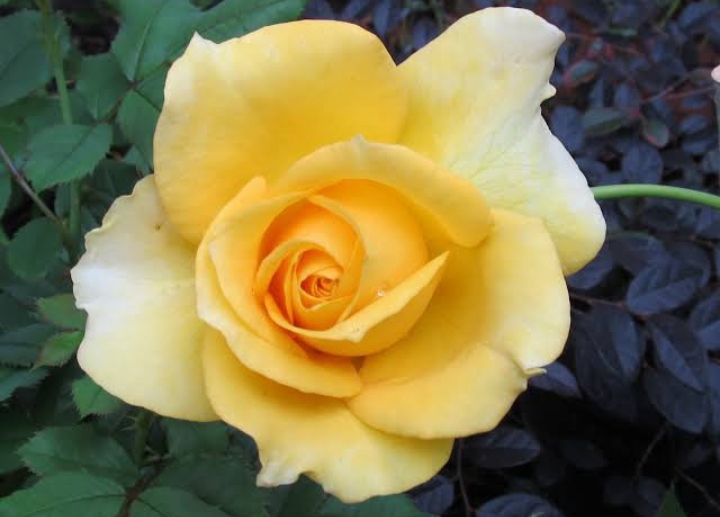
‘Sunshine Daydream’ was bred by Michèle Meilland Richardier around the year 2005. The rose was introduced into the United States by Regan Nursery in 2011. It was also introduced in Germany by BKN Strobel GmbH & Co. in 2013 as ‘Raffaello’
‘Sunshine Dream’ is an upright shrub about 5 to 6 ft. The blooms of this rose are cupped to flat in shape, and they start out as butter yellow in color with lighter edges. As the blooms mature, they turn into a rich cream color. The flowers of this rose can be borne singly or in small clusters.
This rose is good for planting in USDA zones 6-9, which includes areas with average annual minimum temperatures ranging from -10°F to 20°F. In warmer climates, it can be grown in partial shade, but it still requires at least six hours of direct sunlight each day.
The blooms are also fragrant, with a sweet scent that can be described as fruity with notes of peach and apricot. It was named All-America Rose Selections (AARS) winner in 2012. It also won The Honorable John Cecil Award for Open Group in 2013.
Other Facts and Data
| Scientific Name | Rosa ‘Sunshine Dream’ |
| Cultivar Group | Grandiflora |
| Origin | France |
| Year of Breeding | 2005 |
| Year of Introduction | 2011 in USA and 2013 in Germany |
| Breeder | Michèle Meilland Richardier |
| Size | 4 to 6 feet in height |
| Foliage | Dark-green, glossy leaves |
| USDA Zones | 6-9 |
| Marketing Names | ‘Sunshine Daydream’ or ‘Raffaello’ |
| Awards | All-America Rose Selections (AARS) in 2012 and The Honorable John Cecil Award for Open Group in 2013. |
Midas Touch Rose
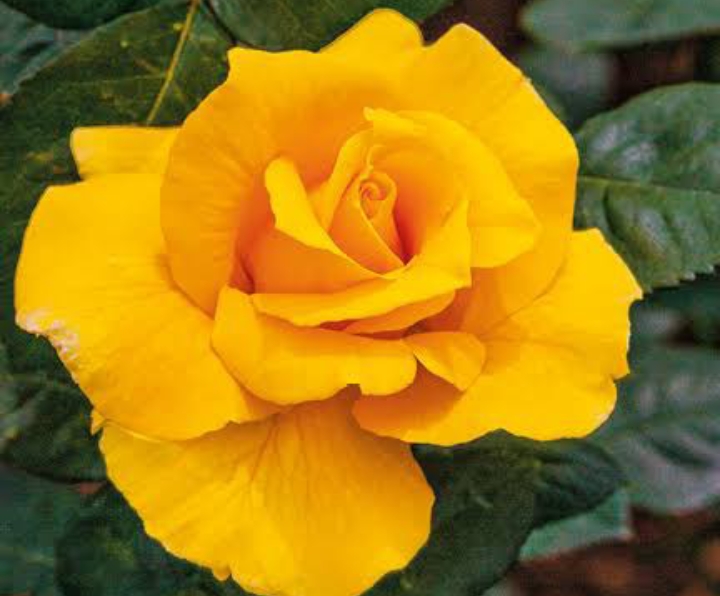
Rosa ‘Midas Touch’, commonly known as the Midas Touch rose, is a hybrid tea rose cultivar that was introduced by Bear Creek Gardens, in the United States in 1994. This beautiful rose is the result of breeding efforts by American hybridizer Jack E. Christensen in 1992.
Midas Touch rose is a bushy variety that grows about 4 to 6 ft in height and produces new blooms throughout the growing season, that is from late spring through to early fall.
The blooms are golden yellow or bright-yellow in color and large, with a high petal count. The blooms also have a fruity scent which is usually strongest in the morning and evening.
In general, the Midas Touch rose prefers a mild climate with moderate temperatures and humidity levels. It can as well tolerate minimum winter temperatures ranging from -10°F to 30°F. It can for sure can grow well in USDA zones 6 through 9.
Other Facts and Data
| Scientific Name | Rosa ‘Midas Touch’ |
| Type of Rose | Hybrid tea rose |
| Origin | United States |
| Year of Breeding | 1992 |
| Year of Introduction | 1994 |
| Breeder | Jack E. Christensen |
| Size | 4 to 6 feet in height |
| Foliage | medium-green leaves |
| USDA Zones | 6-10 |
| Marketing Names | JACtou or Midas rose |
| Awards | All-America Rose Selections (AARS) in 1994. |
The Lady Banks’ rose
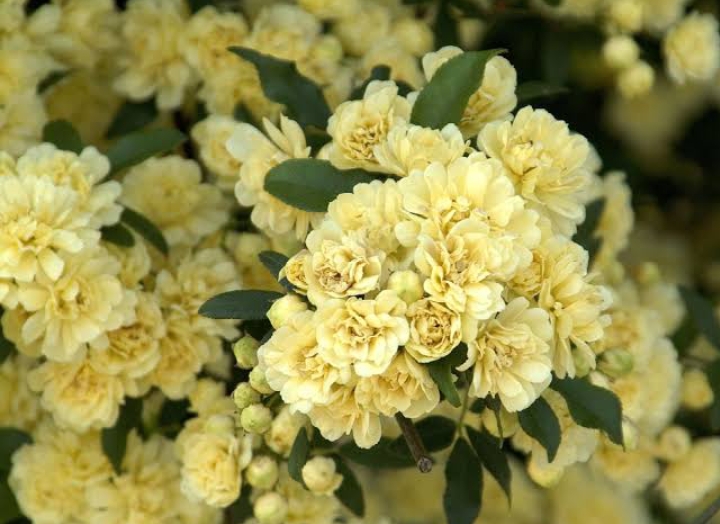
The Lady Banks’ rose, also known as Banks’ rose, is indigenous to the central and western regions of China, specifically in the provinces of Gansu, Guizhou, Henan, Hubei, Jiangsu, Sichuan, and Yunnan. The rose is named after Dorothea Lady Banks, the wife of Sir Joseph Banks, who was a botanist.
Lady Banks’ Rose is virtually thornless with a vigorous growth habit and can climb up to 15 feet or more. It bursts into bloom, covering its entire plant with masses of flowers. The flowers are usually yellow. The blooms are produced in clusters and very fragrant.
Lady Banks’ rose does best in USDA Zones 7-11, which have mild to warm temperatures throughout the year. In USDA Zone 7, it can grow up to 20 feet in length with massive blooms. In warmer zones, such as Zones 9-11, it can grow into a massive shrub that can cover entire walls or arbors.
Other Facts and Data
| Scientific Name | Rosa banksiae |
| Native Area | Central and western China |
| Size | Up to 20 feet in length |
| USDA Zones | 7-11 |
| Nature | Thornless |
| Flowers | Pale yellow |
Also Read: Different Varieties of Red Sunflowers
Golden Celebration
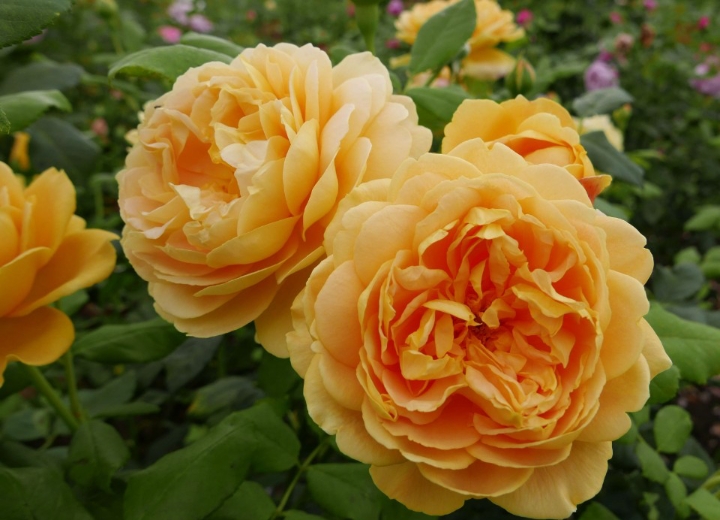
The ‘Golden Celebration’ rose, also known as AUSgold, was bred in 1990 by David C. H. Austin, a renowned British rose breeder. It was first introduced to the market in 1992 and up to today, it is still popular among English Rose Collection.
‘Golden Celebration’ is a bushy shrub rose, 3 to 5 ft. It has large, cup-shaped blooms that are rich golden yellow in color. The flowers have a beautiful fragrance, with a sweet and fruity scent that can be described as having hints of lemon and honey. It also feature medium green foliage, nearly thornless stems and a lax growing habit.
This rose is a hardy variety and can grow well in a range of USDA zones, typically from zones 5 to 9.
In recognition of its exceptional qualities, ‘Golden Celebration’ was awarded the Royal Horticultural Society’s Award of Garden Merit in 2001.
Other Facts and Data
| Scientific Name | Rosa ‘Golden Celebration’ |
| Type of Rose | English rose |
| Origin | United Kingdom |
| Year of Breeding | 1990 |
| Year of Introduction | 1992 |
| Breeder | David C. H. Austin |
| Size | 3 to 5 feet in height |
| Foliage | medium-green leaves |
| USDA Zones | 6-10 |
| Marketing Names | AUSgold, ‘Golden Celebration’ |
| Awards | Royal Horticultural Society’s Award of Garden Merit in 2001. |
Graham Thomas Rose
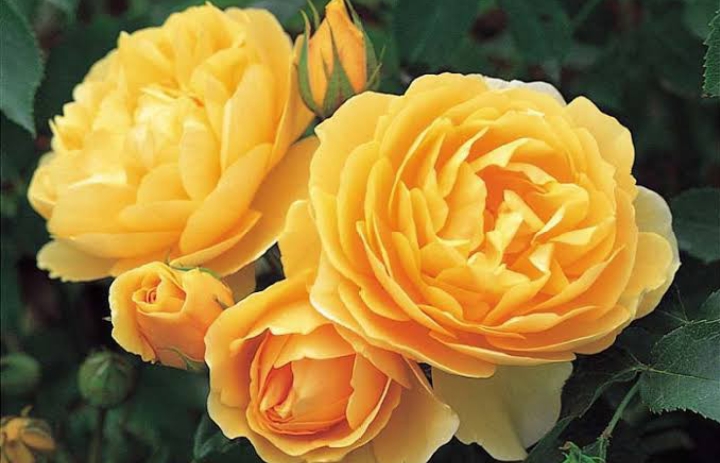
Graham Thomas, also known by its cultivar name AUSmas, was created by British rose breeder David C.H. Austin and introduced to the market in United Kingdom in 1983. The rose was named after Graham Thomas, a renowned horticulturist in the world of roses.
This shrub rose grows to a height of 4 to 5 feet. The flowers are large having a cupped shape with a high center. The petals are firm and ruffled, with a velvety texture.
The color of the entire flower can be described as being “rich deep yellow’ or “golden yellow” and fades to a pale lemon as the bloom ages. The blooms also have a fruity scent that is characteristic of many of David Austin’s rose hybrids.
Graham Thomas flowers are best suited for USDA zones 5-9. Flowers are short-lived, so they do not make good cut flowers.
In 1993, the Royal Horticultural Society recognized the qualities of this rose and awarded it the prestigious Award of Garden Merit. Still in 2009, the rose was inducted into the Rose Hall of Fame, earning the distinction of being called the “World’s Favorite Rose”.
Other Facts and Data
| Scientific Name | Rosa ‘Graham Thomas’ |
| Type of Rose | Climbing English rose |
| Origin | United Kingdom |
| Year of Breeding | 1982 |
| Year of Introduction | 1993 |
| Breeder | David C. H. Austin |
| Size | 4 to 6 feet in height |
| Foliage | Bright to pale green |
| USDA Zones | 5-9 |
| Marketing Names | Ausmas, ‘Lemon Parody’ or Graham Thomas |
| Awards | Royal Horticultural Society’s Award of Garden Merit in 1993. |
Jude the Obscure rose
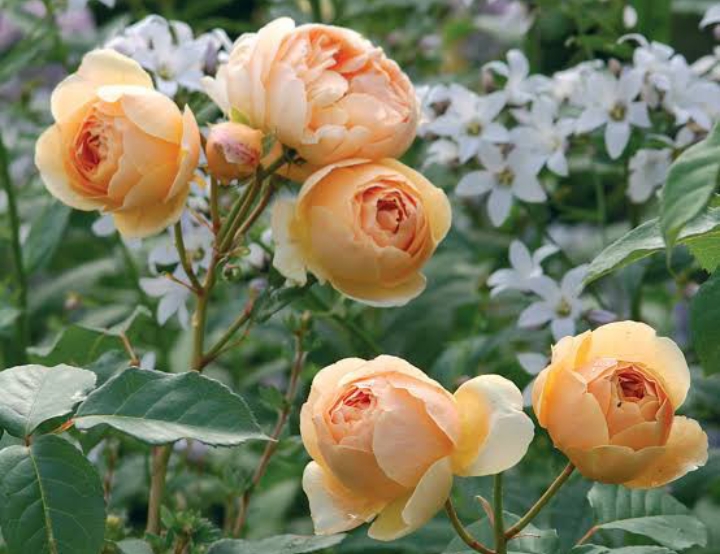
Jude the Obscure, also known as AUSjo, is a rose with a pale apricot hue. It was developed in 1989 by the acclaimed British rose breeder, David C. H. Austin, and was first introduced to the UK market in 1995. The rose is named after Thomas Hardy’s renowned 19th century novel, Jude the Obscure.
‘Jude the Obscure’ is a medium-sized, bushy rose, growing up to 6 feet tall. The flowers are globular with a high centered bloom form. The petals are densely packed and ruffled when they are fully open.
The color of the flowers is creamy yellow and deepens to a pale apricot hue (almost white) at the edges of the petals with age. The flowers are also fragrant, with a fruity scent that is reminiscent of apricots and peaches. In general, the plant is prickly with lax stems.
In general, the Jude the Obscure rose works well for USDA zones 5-9.
Other Facts and Data
| Scientific Name | Rosa ‘Jude the Obscure’ |
| Type of Rose | Climbing English rose |
| Origin | United Kingdom |
| Year of Breeding | 1989 |
| Year of Introduction | 1995 |
| Breeder | David C. H. Austin |
| Size | 4 to 6 feet in height |
| Foliage | semi-glossy, dark green foliage |
| USDA Zones | 5-9 |
| Marketing Names | ‘AUSjo’ or ‘Jude the Obscure’ |
Also Read: Different Types of Yellow Lilies
Rose Charlotte
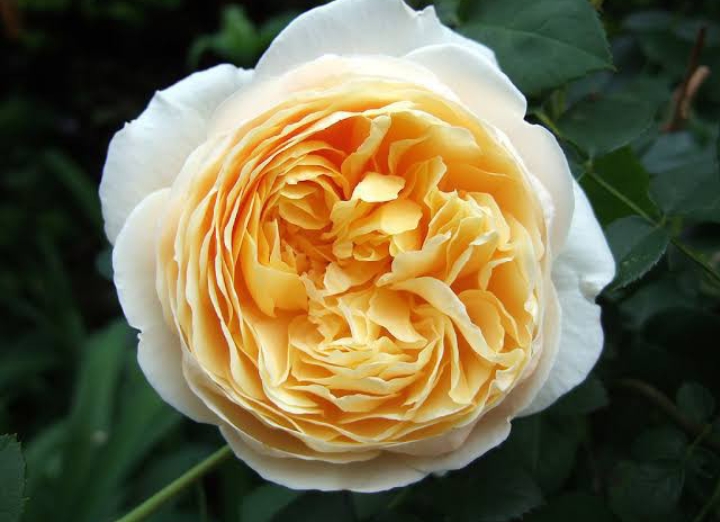
Rose Charlotte is a yellow rose developed by David Austin in 1992. David Austin named this flower Rose Charlotte in honor of one of his granddaughters. Rose Charlotte plant grows between 3 and 6 feet tall.
The flowers are large and have a classic rose shape with a high-centered bloom. The petals are a soft lemon-yellow color and they are delicately ruffled. The flowers have a strong scent that is reminiscent of classic old-fashioned roses. The scent can be described as a mix of fruity, spicy, and floral notes.
The flowers of this rose are long-lasting and they hold up well in cut flower arrangements. Generally, the Rose Charlotte can grow well in zones 5-9, which covers most of the United States, except for the extreme northern and southern regions.
Other Facts and Data
| Scientific Name | Rosa Charlotte |
| Type of Rose | English rose |
| Origin | United Kingdom |
| Year of Breeding | 1992 |
| Year of Introduction | 1994 |
| Breeder | David C. H. Austin |
| Size | 3 to 6 feet in height |
| Foliage | Dark-green |
| USDA Zones | 5-9 |
| Marketing Names | Rose Charlotte |
| Awards | Royal Horticultural Society’s Award of Garden Merit in 1996. |
Crocus Rose
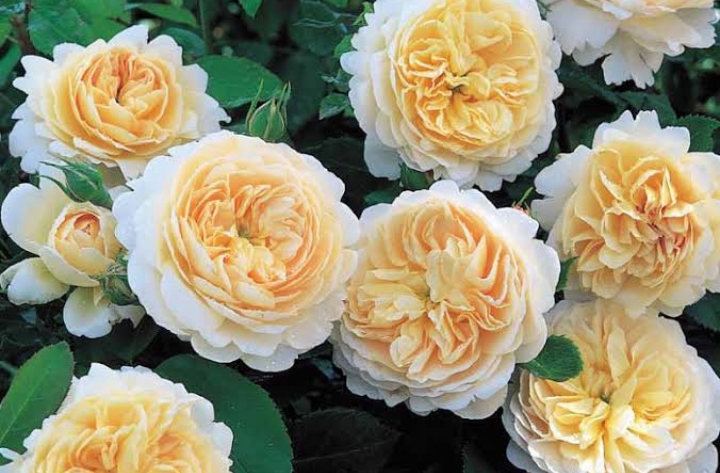
Rosa ‘Crocus Rose’ was bred by English rose breeder David Austin in 1992. It was then first introduced to the market in 2000, and it has since become a popular yellow rose variety.
‘Crocus Rose’ is a medium bushy rose of 3 to 4 feet in height. The flowers are large with cup-shaped blooms. Bloom color is pale yellow or pale apricot, with outer petals that gradually fade to a soft, creamy white towards the edges.
The blooms are borne in clusters and they have a wonderful scent that can be described as a heady mix of myrrh and vanilla.
Rosa ‘Comte de Champagne’
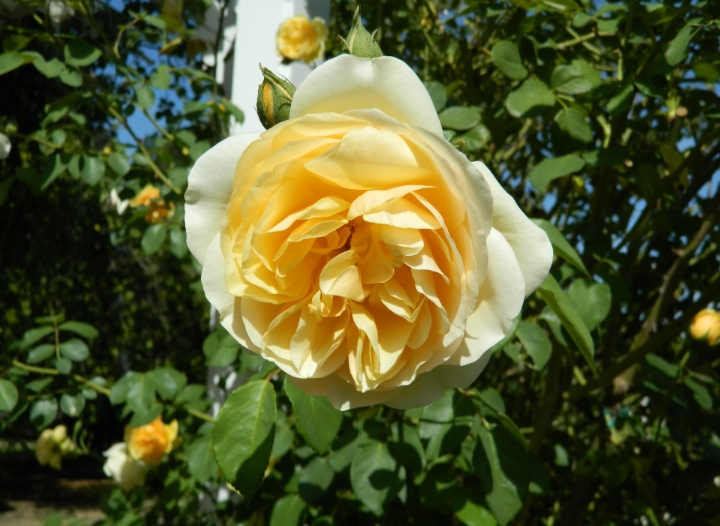
Rosa ‘Comte de Champagne’ is a beautiful rose cultivar that was introduced by the French rose breeder Delbard in 1997. This rose variety is a hybrid tea rose. Its delicate blooms are said to resemble the bubbles in a glass of champagne.The rose was named for the champagne, Comtes de Champagne, produced by the legendery French winery, Taittinger.
Rosa ‘Comte de Champagne’ is a medium-sized, bushy rose, growing up to 6 feet tall. The flowers are a delicate shade of deep yellow at the center, with pale apricot outer petals that gradually fade to a creamy white towards the edges. The blooms are carried in single clusters, and they have a wonderful fragrance that can described as a mix of fruity and honey-like scents.